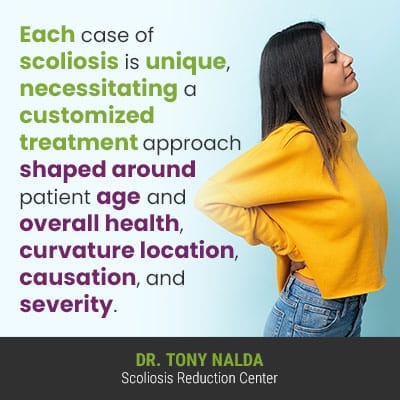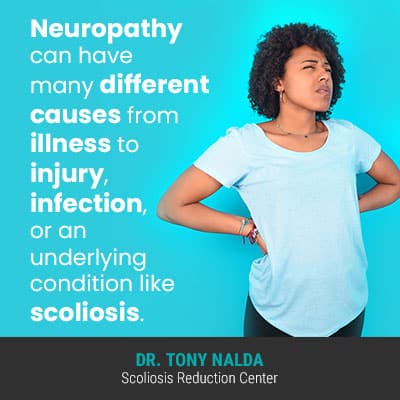Scoliosis can cause a myriad of effects felt throughout the body, particularly if left untreated or not treated proactively. If scoliosis is left to progress, the unnatural spinal curve can increase in size, in addition to increasing adverse spinal tension and the effects it can cause throughout the body, such as neuropathy.
As the spine works in tandem with the brain to form the body’s central nervous system, scoliosis doesn’t just affect the spine but also its surrounding vessels, muscles, and nerves. Neuropathy can develop if a scoliotic curve exposes nerves to uneven pressure, causing damage.
Let’s start our discussion of scoliosis and neuropathy by first defining scoliosis, then neuropathy, followed by how the two are connected.
What is Scoliosis?
If a person is diagnosed with scoliosis, it means they have an unnatural sideways spinal curve, with rotation, making it a 3-dimensional condition.
In addition, a Cobb angle measurement of 10 degrees is needed to meet the parameters of a scoliosis diagnosis.
A patient’s Cobb angle places their condition on a severity scale of mild to moderate and severe to very severe:
- Mild scoliosis: Cobb angle measurement of between 10 and 25 degrees
- Moderate scoliosis: Cobb angle measurement of between 25 and 40 degrees
- Severe scoliosis: Cobb angle measurement of between 40 and 80 degrees
- Very-severe scoliosis: Cobb angle measurement of 80+ degrees
As a progressive structural spinal condition, it’s in the very nature of scoliosis to worsen over time, especially if left untreated.

Each case of scoliosis is unique, necessitating a customized treatment approach shaped around patient age and overall health, curvature location, causation, and severity.
The likelihood of neuropathy will depend on the above factors, plus the degree of nerve involvement and how the condition is treated.
Scoliosis, particularly when affecting the neck, may lead to neuropathy, as the spinal curvature can contribute to neck pain and have broader effects on the body.
C5-C6 disc bulging may contribute to symptoms of neuropathy, while the presence of scoliosis can further exacerbate neuropathic symptoms due to the spinal misalignment’s impact on nerve function.
While scoliosis can often lead to back pain and sometimes hip pain, it is not a direct cause of neuropathy. However, in some cases, severe scoliosis may indirectly contribute to nerve compression or irritation, potentially leading to neuropathic symptoms.
So now that we have defined scoliosis let’s explore neuropathy, including likely symptoms.
What is Neuropathy?
Neuropathy is damage or impairment experienced by one or more nerves, and while different factors come into play, neuropathy can cause sensations of tingling, numbness, or muscle weakness in affected areas.
In many cases, the effects of neuropathy are first felt in the hands and feet, but many other areas of the body can also feel its effects.
The brain and spine work in tandem to form the body’s central nervous system (CNS), and the peripheral nervous system (PNS) consists of the brain and cranial nerves connecting the brain to the spinal cord.
The CNS is often referred to as the body’s control center as it facilitates communication between the brain and parts of the body.
The nervous system consists of a vast network of nerves and cells that connect the brain and spinal cord to the rest of the body by sending and receiving signals, including signals to the hands and feet, legs and arms, internal organs, muscles, and the mouth and face.
When neuropathy occurs, the nerves are not working as they should because they are damaged, impairing their function, and this often involves sending incorrect messages and signals throughout the body.
For example, nerves might send pain signals when there is no scoliosis pain or vice versa. This is why neuropathy can cause a lot of discomfort and is often described as an unpredictable condition.
When it comes to treating neuropathy, the most important factor is determining its underlying cause. Otherwise, only the symptoms of neuropathy are being addressed, and not the condition itself.

Neuropathy can have many different causes from illness to injury, infection, or an underlying condition like scoliosis.
There are also different types of neuropathy with different causes and treatment needs.
Different Types of Neuropathy
There are over 100 different types of peripheral neuropathy, and neuropathies are further classified by specifying the type of nerve damage involved.
Scoliosis, particularly neuromuscular scoliosis, can occasionally contribute to neurological symptoms, but it is not typically associated with causing conditions like headaches, urinary problems, or multiple sclerosis.
Mononeuropathy is classified when damage to a single nerve is detected, while polyneuropathy is more common and involves damage to multiple nerves.
The three main types of peripheral nerves include sensory, motor, and autonomic nerves.
The sensory nerves connect to the skin, controlling sensation. In contrast, the motor nerves connect to the muscles, controlling movement, reflexes, and coordination, and the autonomic nerves connect to the body’s internal organs, controlling breathing, heart rate, and digestion.
Neuropathy can involve one of these types of nerves, or can affect all three.
Symptoms of sensory neuropathy can include:
- Sensations of numbness, burning, and tingling in the hands or feet
- Paresthesias (strange sensations such as standing in water)
- Coordination changes
- Reflex changes
- Pain
- Inability to feel pain, temperature changes, and sensations like touch
Symptoms of motor neuropathy can include:
- Weak muscles
- A loss of muscle control
- Muscle cramps
- Muscle twitches
- Muscle spasms
- Impaired coordination and/or balance
- Reduced range of motion in affected areas
Symptoms of autonomic neuropathy can include:
- Dizziness
- Fainting spells
- Nausea and/or vomiting
- Diarrhea
- Fluctuating blood pressure
- Abnormal heart rate
- Sexual dysfunction
As you can see, there is a wide range of neuropathy symptoms that can affect many systems at work within the body.
Symptoms of neuropathy can be known to worsen quickly and then slow down, while some cases involve marked periods of relapse and remission. It’s also important not to confuse neuropathy with sciatica pain.
It’s estimated that approximately 30 percent of neuropathy cases are related to diabetes, and 30 to 40 percent are classified as idiopathic, meaning not clearly associated with a single-known cause.
While scoliosis itself is a condition characterized by an abnormal curvature of the spine, it is generally not known to directly cause neuropathy.
However, in some cases, scoliosis may lead to other spinal issues like retrolisthesis or arthritis, which could potentially contribute to nerve compression and neuropathic symptoms. It’s essential to consult with a healthcare professional to determine the specific causes of neuropathy and address any underlying spinal conditions like scoliosis.
So now that we have defined scoliosis and the different types of neuropathy, including common symptoms, let’s discuss the potential connection between neuropathy and scoliosis.
Scoliosis and Neuropathy
Mild forms of scoliosis are not easy to detect because they don’t commonly cause noticeable functional deficits or postural changes, and in the condition’s most-prevalent form (adolescent idiopathic scoliosis), it’s not commonly painful, making mild scoliosis symptoms subtle.
As mentioned earlier, the brain and spinal cord work together to form the central nervous system; the peripheral nervous system includes the nerves branching out from the central nervous system to reach additional body parts, muscles, and organs.
Although scoliosis is more closely connected to the function of the CNS, in severe forms of scoliosis, the connection between the CNS nerves and the PNS nerves can also be affected.
With keeping the three main types of nerves in mind (sensory, motor, and autonomic), scoliosis is most closely linked to motor neuropathy because it’s the motor nerves that control muscles and movement.
This is because it’s not just the spine that maintains its alignment and healthy curves; it also relies on surrounding muscles to help support and stabilize the spine.
If there is a disruption in brain-body communication, this includes the muscles, and if an unnatural scoliotic curve is compressing the spine and its surrounding vessels, muscles, and nerves, the nerves involved can experience functional deficits and become damaged or destroyed: neuropathy.
Because scoliosis can impact the spine’s overall health and function, it can cause neuropathy by affecting the spinal nerves. In addition, it can also lead to the development of neuropathy by making the spine vulnerable to a variety of additional spinal conditions known to disrupt nervous-system activity.
Conclusion
As a spinal condition, scoliosis can produce a myriad of effects felt throughout the body, and as the spine and brain work together to facilitate brain-body communication, the spine is involved in the optimal function of virtually every working system within the body.
While scoliosis itself may not directly cause neuropathy, in severe cases, it can contribute to conditions like dowager’s hump, cervical lordosis, and cervical radiculopathy, which may lead to nerve-related symptoms and discomfort.
As scoliosis is an unnatural spinal curve, it introduces uneven forces to the body and adverse spinal tension that affects the spine and its surroundings, including vessels, muscles, and nerves.
If left untreated, in severe forms, scoliosis can cause neuropathy by exposing spinal nerves to constant compression, which can cause them to become inflamed, irritated, damaged, or destroyed.
In addition, in order for the spine to function optimally, it has to maintain its natural curvatures and alignment. So, a spinal condition, like scoliosis, that causes a loss of the spine’s healthy curves, meaning its biomechanics are disrupted, impacts the spine’s overall health: making it more vulnerable to a number of spinal conditions.
Here at the Scoliosis Reduction Center®, there are a number of spinal conditions I have experience treating, and part of the reason I value proactive treatment is to avoid progression, increasing condition severity, and the development of serious complications as a result, such as neuropathy.
When neuropathy is a symptom, I address it by treating its underlying cause: scoliosis itself.
By integrating multiple treatment disciplines such as condition-specific chiropractic care, in-office therapy, and custom-prescribed home exercises, I can work towards reducing a scoliotic curve on a structural level, while increasing core strength so the spine is optimally supported/stabilized.
As scoliosis is impacted on multiple levels, so too are the condition’s related complications, such as neuropathy; as scoliosis is reduced, the compression it causes is also reduced, taking pressure off impacted nerves.




